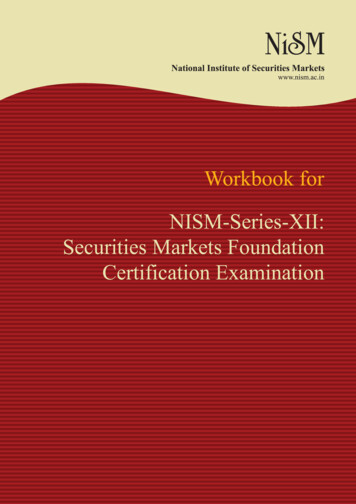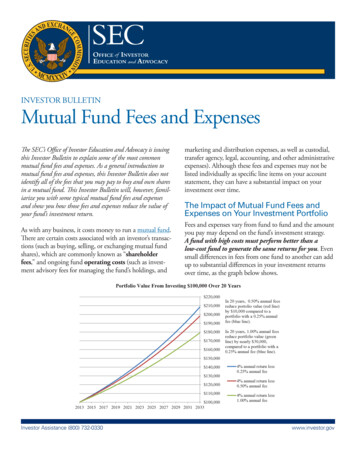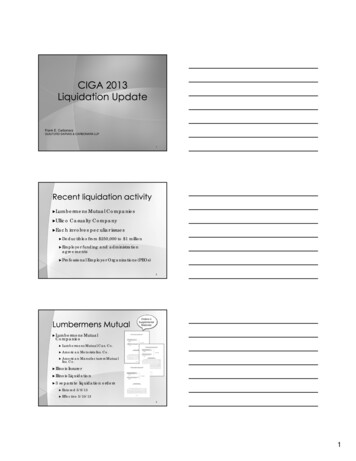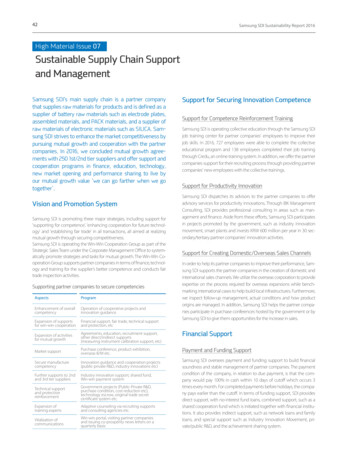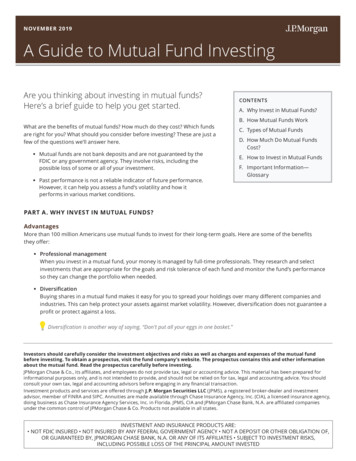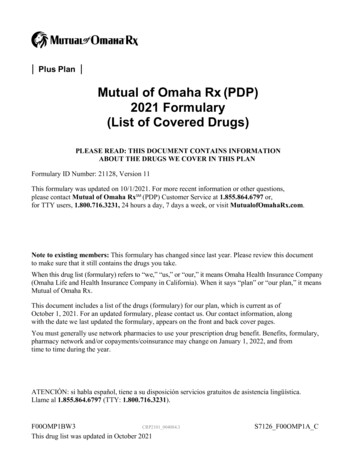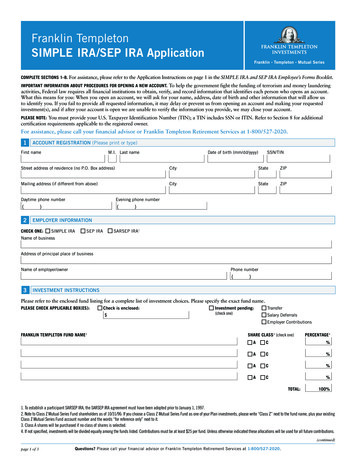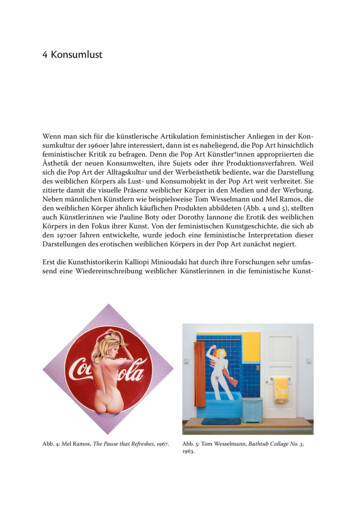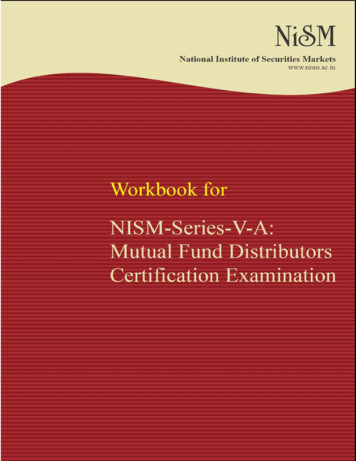
Transcription
NISM-Series-V-A: Mutual Fund Distributors Certification ExaminationWorkbook forNISM-Series-V-A: Mutual Fund DistributorsCertification ExaminationNational Institute of Securities Marketswww.nism.ac.in1
NISM-Series-V-A: Mutual Fund Distributors Certification ExaminationThis workbook has been developed to assist candidates in preparing for the National Instituteof Securities Markets (NISM) Certification Examination for Mutual Fund Distributors.Workbook Version: August 2014Published by:National Institute of Securities Markets National Institute of Securities Markets, 2014Plot 82, Sector 17, VashiNavi Mumbai – 400 703, IndiaAll rights reserved. Reproduction of this publication in any form without prior permission ofthe publishers is strictly prohibited.2
NISM-Series-V-A: Mutual Fund Distributors Certification ExaminationDisclaimerThe contents of this publication do not necessarily constitute or imply its endorsement,recommendation, or favouring by the National Institute of Securities Market (NISM) or theSecurities and Exchange Board of India (SEBI). This publication is meant for general readingand educational purpose only.The statements/explanations/concepts are of general nature and may not have taken intoaccount the particular objective/ move/ aim/ need/ circumstances of individual user/ reader/organization/ institute. Thus NISM and SEBI do not assume any responsibility for any wrongmove or action taken based on the information available in this publication.Therefore before acting on or following the steps suggested on any theme or before followingany recommendation given in this publication user/reader should consider/seek professionaladvice.The publication contains information, statements, opinions, statistics and materials that havebeen obtained from sources believed to be reliable and the publishers of this title have madebest efforts to avoid any errors. However, publishers of this material offer no guarantees andwarranties of any kind to the readers/users of the information contained in this publication.Since the work and research is still going on in all these knowledge streams, NISM and SEBIdo not warrant the totality and absolute accuracy, adequacy or completeness of thisinformation and material and expressly disclaim any liability for errors or omissions in thisinformation and material herein. NISM and SEBI do not accept any legal liability whatsoeverbased on any information contained herein.While the NISM Certification examination will be largely based on material in this workbook,NISM does not guarantee that all questions in the examination will be from material coveredherein.3
NISM-Series-V-A: Mutual Fund Distributors Certification ExaminationAbout NISMIn pursuance of the announcement made by the Finance Minister in his Budget Speech inFebruary 2005, Securities and Exchange Board of India (SEBI) has established the NationalInstitute of Securities Markets (NISM) in Mumbai.SEBI, by establishing NISM, has articulated the desire expressed by the Indian government topromote securities market education and research.Towards accomplishing the desire of Government of India and vision of SEBI, NISM haslaunched an effort to deliver financial and securities education at various levels and acrossvarious segments in India and abroad. To implement its objectives, NISM has established sixdistinct schools to cater the educational needs of various constituencies such as investor,issuers, intermediaries, regulatory staff, policy makers, academia and future professionals ofsecurities markets.NISM brings out various publications on securities markets with a view to enhance knowledgelevels of participants in the securities industry.NISM is mandated to implement certification examinations for professionals employed invarious segments of the Indian securities markets.4
NISM-Series-V-A: Mutual Fund Distributors Certification ExaminationAcknowledgementThis workbook has been developed by NISM in consultation with the Examination Committeefor Mutual Fund Distributors Certification Examination consisting of representatives ofAssociation of Mutual Funds in India (AMFI). NISM gratefully acknowledges the contributionof all committee members.About the AuthorThis workbook has been developed for NISM by Mr. Sundar Sankaran, Director, FinberryAcademy.5
NISM-Series-V-A: Mutual Fund Distributors Certification ExaminationAbout the Certification Examination for Mutual Fund DistributorsThe examination seeks to create a common minimum knowledge benchmark for all personsinvolved in selling and distributing mutual funds including: Individual Mutual Fund DistributorsEmployees of organizations engaged in sales and distribution of Mutual FundsEmployees of Asset Management Companies specially persons engaged in sales anddistribution of Mutual FundsThe certification aims to enhance the quality of sales, distribution and related supportservices in the mutual fund industry.Examination ObjectivesOn successful completion of the examination, the candidate should: Know the basics of mutual funds, their role and structure, different kinds of mutual fundschemes and their features. Understand how mutual funds are distributed in the market-place, how schemes are tobe evaluated, and how suitable products and services can be recommended to investorsand prospective investors in the market. Get oriented to the legalities, accounting, valuation and taxation aspects underlyingmutual funds and their distribution. Get acquainted with financial planning as an approach to investing in mutual funds, andan aid for advisors to develop long term relationships with their clients.Assessment StructureThe examination consists of 100 questions of 1 mark each and should be completed in 2 hours.The passing score for the examination is 50%. There shall be no negative marking.How to register and take the examinationTo find out more and register for the examination please visit www.nism.ac.in6
NISM-Series-V-A: Mutual Fund Distributors Certification ExaminationCONTENTSCHAPTER 1: CONCEPT AND ROLE OF A MUTUAL FUND . 111.1Introduction. 111.2Types of Funds. 171.3Key Developments over the Years . 25CHAPTER 2: FUND STRUCTURE AND CONSTITUENTS . 312.1Legal Structure of Mutual Funds in India . 312.2Key Constituents of a Mutual Fund . 332.3Other Service Providers. 36CHAPTER 3: LEGAL AND REGULATORY ENVIRONMENT . 413.1Role of Regulators in India . 413.2Investment Restrictions for Schemes . 453.3Investors’ Rights & Obligations . 473.4Can a Mutual Fund Scheme go bust? . 523.5Appendix 1: AMFI Code of Ethics . 533.6Appendix 2: AMFI’s Code of Conduct for Intermediaries of Mutual Funds . 59CHAPTER 4: OFFER DOCUMENT . 674.1Offer Document – NFO, SID, SAI . 674.2Key Information Memorandum . 734.3Appendix 3: Format of Scheme Information Document (SID) . 754.4Appendix 4: Key Information Memorandum . 96CHAPTER 5: FUND DISTRIBUTION AND CHANNEL MANAGEMENT PRACTICES . 1035.1Distribution Channels . 1035.2Channel Management Practices . 109CHAPTER 6: ACCOUNTING, VALUATION AND TAXATION . 1176.1Accounting and Expenses . 1177
NISM-Series-V-A: Mutual Fund Distributors Certification Examination6.2Valuation . 1276.3Taxation . 127CHAPTER 7: INVESTOR SERVICES . 1377.1Mutual Fund Investors . 1377.2KYC Requirements for Mutual Fund Investors . 1397.3PAN Requirements and Micro-SIPs . 1407.4Additional Documentation Requirements applicable for Institutional Investors . 1427.5Demat Account . 1427.6Transactions with Mutual Funds . 1437.7Transactions through the Stock Exchange . 1507.8Investment Plans and Services . 1507.9Appendix 5: KYC Form for Individuals . 1577.10 Appendix 6: KYC Form for Non-individuals . 1597.11 Appendix 7: KYC Change Form for Individuals . 162CHAPTER 8: RETURN, RISK& PERFORMANCE OF FUNDS . 1678.1Drivers of Returns in a Scheme . 1678.2Measures of Returns . 1738.3Drivers of Risk in a Scheme . 1788.4Measures of Risk . 1868.5Benchmarks and Performance . 1878.6Quantitative Measures of Fund Manager Performance . 191CHAPTER 9: SCHEME SELECTION . 1979.1How to choose between Scheme Categories?. 1979.2How to select a Scheme within a Scheme Category? . 2049.3Which is the Better Option within a Scheme? . 2069.4Sources of Data to track Mutual Fund Performance . 2078
NISM-Series-V-A: Mutual Fund Distributors Certification ExaminationCHAPTER 10: SELECTING THE RIGHT INVESTMENT PRODUCTS FOR INVESTORS . 21310.1 Financial and Physical Assets . 21310.2 Gold – Physical or Financial? . 21510.3 Real Estate – Physical or Financial?. 21610.4 Fixed Deposit or Debt Scheme . 21710.5 National Pension System (NPS) . 21810.6 Other Financial Products . 219CHAPTER 11: HELPING INVESTORS WITH FINANCIAL PLANNING . 22311.1 Introduction to Financial Planning . 22311.2 Alternate Financial Planning Approaches . 22811.3 Life Cycle and Wealth Cycle in Financial Planning . 228CHAPTER 12: RECOMMENDING MODEL PORTFOLIOS AND FINANCIAL PLANS . 23512.1 Risk Profiling . 23512.2 Asset Allocation . 23712.3 Model Portfolios. 238List of Abbreviations . 2429
NISM-Series-V-A: Mutual Fund Distributors Certification ExaminationThis page has been intentionally kept blank10
NISM-Series-V-A: Mutual Fund Distributors Certification ExaminationCHAPTER 1: CONCEPT AND ROLE OF A MUTUAL FUNDLearning ObjectiveThis Chapter seeks to introduce the concept of mutual funds, highlight the advantages theyoffer, and describe the salient features of various types of mutual fund schemes.Details of how to evaluate them, and their fitment in an investor’s portfolio are discussed inthe second half of this Workbook1.1 Introduction1.1.1 Concept of Mutual FundMutual fund is a vehicle to mobilize moneys from investors, to invest in different markets andsecurities, in line with the investment objectives agreed upon, between the mutual fund andthe investors. In other words, through investment in a mutual fund, a small investor can availof professional fund management services offered by an asset management company.1.1.2 Role of Mutual FundsMutual funds perform different roles for different constituencies.Their primary role is to assist investors in earning an income or building their wealth, byparticipating in the opportunities available in various securities and markets. It is possible formutual funds to structure a scheme for any kind of investment objective. Thus, the mutualfund structure, through its various schemes, makes it possible to tap a large corpus of moneyfrom diverse investors.Therefore, the mutual fund offers schemes. In the industry, the words ‘fund’ and ‘scheme’ areused inter-changeably. Various categories of schemes are called “funds”. In order to ensureconsistency with what is experienced in the market, this Workbook goes by the industrypractice. However, wherever a difference is required to be drawn, the scheme offering entityis referred to as “mutual fund” or “the fund”.The money that is raised from investors, ultimately benefits governments, companies or otherentities, directly or indirectly, to raise moneys to invest in various projects or pay for variousexpenses.As a large investor, the mutual funds can keep a check on the operations of the investeecompany, and their corporate governance and ethical standards.11
NISM-Series-V-A: Mutual Fund Distributors Certification ExaminationThe projects that are facilitated through such financing, offer employment to people; theincome they earn helps the employees buy goods and services offered by other companies,thus supporting projects of these goods and services companies. Thus, overall economicdevelopment is promoted.The mutual fund industry itself, offers livelihood to a large number of employees of mutualfunds, distributors, registrars and various other service providers.Higher employment, income and output in the economy boost the revenue collection of thegovernment through taxes and other means. When these are spent prudently, it promotesfurther economic development and nation building.Mutual funds can also act as a market stabilizer, in countering large inflows or outflows fromforeign investors. Mutual funds are therefore viewed as a key participant in the capital marketof any economy.1.1.3 Why Mutual Fund Schemes?Mutual funds seek to mobilize money from all possible investors. Various investors havedifferent investment preferences. In order to accommodate these preferences, mutual fundsmobilize different pools of money. Each such pool of money is called a mutual fund scheme.Every scheme has a pre-announced investment objective. When investors invest in a mutualfund scheme, they are effectively buying into its investment objective.1.1.4 How do Mutual Fund Schemes Operate?Mutual fund schemes announce their investment objective and seek investments from thepublic. Depending on how the scheme is structured, it may be open to accept money frominvestors, either during a limited period only, or at any time.The investment that an investor makes in a scheme is translated into a certain number of‘Units’ in the scheme. Thus, an investor in a scheme is issued units of the scheme.Under the law, every unit has a face value of Rs. 10. (However, older schemes in the marketmay have a different face value). The face value is relevant from an accounting perspective.The number of units multiplied by its face value (Rs. 10) is the capital of the scheme – its UnitCapital.The scheme earns interest income or dividend income on the investments it holds. Further,when it purchases and sells investments, it earns capital gains or incurs capital losses. Theseare called realized capital gains or realized capital losses as the case may be.Investments owned by the scheme may be quoted in the market at higher than the cost paid.Such gains in values on securities held are called valuation gains. Similarly, there can be12
NISM-Series-V-A: Mutual Fund Distributors Certification Examinationvaluation losses when securities are quoted in the market at a price below the cost at whichthe scheme acquired them.Running the scheme leads to its share of operating expenses (to be discussed in Chapter6).Investments can be said to have been handled profitably, if the following profitability metricis positive:(A) Interest income(B) Dividend income(C) Realized capital gains(D) Valuation gains(E) – Realized capital losses(F) – Valuation losses(G) – Scheme expensesWhen the investment activity is profitable, the true worth of a unit goes up; when there arelosses, the true worth of a unit goes down. The true worth of a unit of the scheme is otherwisecalled Net Asset Value (NAV) of the scheme. The concept of NAV is elaborated in Chapter6.When a scheme is first made available for investment, it is called a ‘New Fund Offer’ (NFO).During the NFO, investors may have the chance of buying the units at their face value. PostNFO, when they buy into a scheme, they need to pay a price that is linked to its NAV.The money mobilized from investors is invested by the scheme as per the investmentobjective committed. Profits or losses, as the case might be, belong to the investors. Theinvestor does not however bear a loss higher than the amount invested by him.Various investors subscribing to an investment objective might have different expectationson how the profits are to be handled. Some may like it to be paid off regularly as dividends.Others might like the money to grow in the scheme. Mutual funds address such differentialexpectations between investors within a scheme, by offering various options, such as dividendpayout option, dividend re-investment option and growth option. The implications of eachof these options are discussed in Chapter7. An investor buying into a scheme gets to selectthe preferred option also.The relative size of mutual fund companies is assessed by their assets under management(AUM). When a scheme is first launched, assets under management would be the amountmobilized from investors. Thereafter, if the scheme has a positive profitability metric, its AUMgoes up; a negative profitability metric will pull it down.Further, if the scheme is open to receiving money from investors even post-NFO, then suchcontributions from investors boost the AUM. Conversely, if the scheme pays any money tothe investors, either as dividend or as consideration for buying back the units of investors, theAUM falls.13
NISM-Series-V-A: Mutual Fund Distributors Certification ExaminationThe AUM thus captures the impact of the profitability metric and the flow of unit-holdermoney to or from the scheme.1.1.5 Advantages of Mutual Funds for InvestorsProfessional ManagementMutual funds offer investors the opportunity to earn an income or build their wealth throughprofessional management of their investible funds. There are several aspects to suchprofessional management viz. investing in line with the investment objective, investing basedon adequate research, and ensuring that prudent investment processes are followed.Affordable Portfolio DiversificationUnits of a scheme give investors exposure to a range of securities held in the investmentportfolio of the scheme. Thus, even a small investment of Rs. 500 in a mutual fund schemecan give investors a diversified investment portfolio.As will be seen in Chapter12, with diversification, an investor ensures that all the eggs are notin the same basket. Consequently, the investor is less likely to lose money on all theinvestments at the same time. Thus, diversification helps reduce the risk in investment. Inorder to achieve the same diversification as a mutual fund scheme, investors will need to setapart several lakhs of rupees. Instead, they can achieve the diversification through aninvestment of less than thousand rupees in a mutual fund scheme.Economies of ScaleThe pooling of large sums of money from so many investors makes it possible for the mutualfund to engage professional managers to manage the investment. Individual investors withsmall amounts to invest cannot, by themselves, afford to engage such professionalmanagement.Large investment corpus leads to various other economies of scale. For instance, costs relatedto investment research and office space get spread across investors. Further, the highertransaction volume makes it possible to negotiate better terms with brokers, bankers andother service providers.Thus, investing through a mutual fund offers a distinct economic advantage to an investor ascompared to direct investing in terms of cost saving.Liquidity14
NISM-Series-V-A: Mutual Fund Distributors Certification ExaminationAt times, investors in financial markets are stuck with a security for which they can’t find abuyer – worse, at times they can’t find the company they invested in! Such investments,whose value the investor cannot easily realise in the market, are technically called illiquidinvestments and may result in losses for the investor.Investors in a mutual fund scheme can recover the value of the moneys invested, from themutual fund itself. Depending on the structure of the mutual fund scheme, this would bepossible, either at any time, or during specific intervals, or only on closure of the scheme.Schemes, where the money can be recovered from the mutual fund only on closure of thescheme, are listed in a stock exchange. In such schemes, the investor can sell the units in thestock exchange to recover the prevailing value of the investment.Tax DeferralAs will be discussed in Chapter6, mutual funds are not liable to pay tax on the income theyearn. If the same income were to be earned by the investor directly, then tax may have to bepaid in the same financial year.Mutual funds offer options, whereby the investor can let the moneys grow in the scheme forseveral years. By selecting such options, it is possible for the investor to defer the tax liability.This helps investors to legally build their wealth faster than would have been the case, if theywere to pay tax on the income each year.Tax benefitsSpecific schemes of mutual funds (Equity Linked Savings Schemes) give investors the benefitof deduction of the amount subscribed (upto Rs. 150,000 in a financial year), from theirincome that is liable to tax. This reduces their taxable income, and therefore the tax liability.The Rajiv Gandhi Equity Savings Scheme (RGESS) offers a rebate to first time retail investors(in equity or mutual funds) with annual income upto Rs. 12 lakhs. Mutual funds announcespecific equity-oriented schemes that are eligible for the RGESS benefit.The RGESS benefit is linked to amount invested (excluding brokerage, securities transactiontax, service tax, stamp duty and all taxes appearing in the contract note). Rebate of 50% ofthe amount invested upto Rs. 50,000, can be claimed as a deduction from taxable income.The investment limit of Rs. 50,000 is applicable for a block of three financial years, startingwith the year of first investment.Thus, if an investor invests Rs. 30,000 in RGESS schemes in a financial year, then he can reducehis taxable income for that previous year by 50% of Rs. 30,000 i.e. Rs. 15,000. In the followingyear, he still has an investment limit of Rs. 20,000 available. The maximum deduction that canbe made from the taxable income over the period of three financial years is 50% of Rs. 50,000i.e. Rs. 25,000.15
NISM-Series-V-A: Mutual Fund Distributors Certification ExaminationDividends received from mutual fund schemes are tax-free in the hands of the investors.However, dividends from certain categories of schemes are subject to dividend distributiontax, which is paid by the scheme before the dividend is distributed to the investor. Long termcapital gains arising out of sale of some categories of schemes are subject to long term capitalgains tax, which may be taxed at a different (and often lower) rate of tax or even entirely taxexempt. Taxation is discussed in detail in Chapter 6.Convenient OptionsThe options offered under a scheme allow investors to structure their investments in line withtheir liquidity preference and tax position.There is also great transaction conveniences like the ability of withdraw only part of themoney from the investment account, ability to invest additional amounts to the account,setting up systematic transactions, etc.Investment ComfortOnce an investment is made with a mutual fund, they make it convenient for the investor tomake further purchases with very little documentation. This simplifies subsequentinvestment activity.Regulatory ComfortThe regulator, Securities & Exchange Board of India (SEBI), has mandated strict checks andbalances in the structure of mutual funds and their activities. These are detailed in thesubsequent Chapters. Mutual fund investors benefit from such protection.Systematic Approach to InvestmentsMutual funds also offer facilities that help investor invest amounts regularly through aSystematic Investment Plan (SIP); or withdraw amounts regularly through a SystematicWithdrawal Plan (SWP); or move moneys between different kinds of schemes through aSystematic Transfer Plan (STP). Such systematic approaches promote an investmentdiscipline, which is useful in long-term wealth creation and protection. SWPs allow theinvestor to structure a regular cash flow from the investment account.1.1.6 Limitations of a Mutual FundLack of portfolio customization16
NISM-Series-V-A: Mutual Fund Distributors Certification ExaminationSome securities houses offer Portfolio Management Schemes (PMS) to large investors. In aPMS, the investor has better control over what securities are bought and sold on his behalf.The investor can get a customised portfolio in case of PMS.On the other hand, a unit-holder in a mutual fund is just one of several thousand investors ina scheme. Once a unit-holder has bought into the scheme, investment management is left tothe fund manager (within the broad parameters of the investment objective). Thus, the unitholder cannot influence what securities or investments the scheme would buy.Large sections of investors lack the time or the knowledge to be able to make portfoliochoices. Therefore, lack of portfolio customization is not a serious limitation in most cases.Choice overloadOver 1,800 mutual fund schemes offered by 45 mutual funds – and multiple options withinthose schemes – make it difficult for investors to choose between them. Greaterdissemination of industry information through various media and availability of professionaladvisors in the market should help investors handle this overload.No control over costsAll the investor's moneys are pooled together in a scheme. Costs incurred for managing thescheme are shared by all the Unit-holders in proportion to their holding of Units in thescheme. Therefore, an individual investor has no control over the costs in a scheme.SEBI has however imposed certain limits on the expenses that can be charged to any scheme.These limits, which vary with the size of assets and the nature of the scheme, are discussedin Chapter 6.1.2 Types of FundsThis section introduces some funds to the reader. The risk aspects underlying these funds andtheir suitability for different kinds of investors are discussed in later Chapters.1.2.1 Open-Ended Funds, Close-Ended Funds and Interval FundsOpen-ended funds are open for investors to enter or exit at any time, even after the NFO.When existing investors acquire
NISM-Series-V-A: Mutual Fund Distributors Certification Examination 2 This workbook has been developed to assist candidates in preparing for the National Institute of Securities Markets (NISM) Certification Examination for Mutual Fund Distributors. Workbook Version: August 2014 Published by: National Institute of Securities Markets
